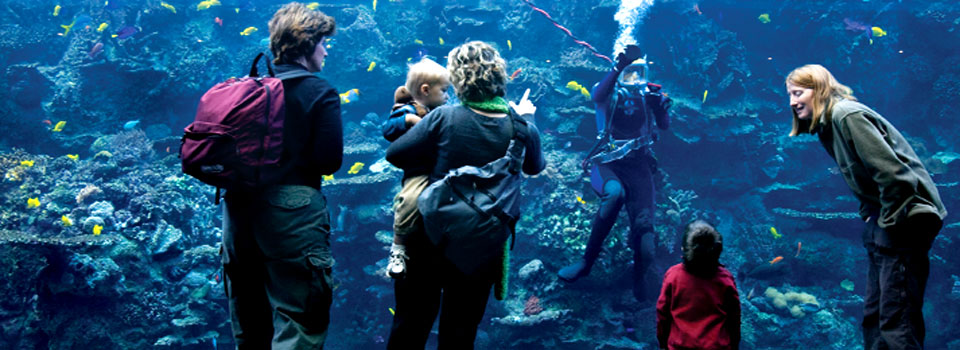Al Camus leans into the microscope, studying the tissue samples taken earlier from a black banded darter.
“It looks clear,” he says, turning to Susan Knowles to make certain she sees the same results. After a moment Knowles, a second-year resident, nods in agreement, “I don’t see any parasites either.”
Camus, associate professor of pathology in UGA’s College of Veterinary Medicine, goes virtually unnoticed to the average Georgia Aquarium visitor, but that’s the nature of his job. Thanks to a partnership between UGA and the Aquarium, threatening parasites can be prevented from spreading to the nearly 500 species of fish and mammals housed within the 523,000 square-foot building.
Georgia Aquarium is the largest facility to integrate a veterinary teaching hospital into an aquarium, says Kristie Cobb, director of the Aquarium’s membership and annual programs.
“This partnership is unique in that we provide space for faculty and students of a nearby university,” Cobb says. “It increases the Aquarium’s commitment to science and adds credibility because UGA provides research that we can share with other institutions and become a resource for other aquatic facilities.”
Information gathered at the Aquarium is shared with conservation organizations throughout the world. This, in turn, provides a greater understanding for and protection of many of the species that are studied.
Operating out of the Correll Center for Aquatic Animal Health-named in honor of Pete and Ada Lee Correll, who donated $2.5 million to establish the 10,500-square-foot hospital-Camus travels from Athens to the Aquarium in Atlanta two to three times a week.
“Many diagnoses can be made through visual examination,” Camus says, “however, more complicated cases may require further investigation using resources at our facilities at UGA.”
The veterinary staff at the Aquarium depends on the diagnostic services from the College of Veterinary Medicine, which include not only pathology through Camus’ expertise, but also microbiology through the efforts of Susan Sanchez in the Athens Diagnostic Laboratory at the veterinary college.
“It takes a lot of time just to care for the aquatic life in a large collection,” says Tonya Clauss, Georgia Aquarium’s manager of veterinary services. “By having Dr. Camus here, we are able to investigate problems and obtain invaluable information about the animals while improving our clinical medicine practices.”
Equally important is the impact the partnership has on the residents. By working through active cases and assisting in exams, the students gain invaluable experience. First-year resident David Marancik sees his experience as a unique learning opportunity.
“There are very few residency programs dealing with aquatic pathology, and there’s so much potential and work to be done in this field in terms of conservation medicine, aquaculture, aquarium management, and research,” Marancik says. “And I think that exposure is really invaluable.”
Since the partnership began in 2006, the residents have assisted Camus and the Aquarium staff with some of the largest cases at the Aquarium.
“The studies our pathology residents participate in at such a unique facility are opportunities that no other university can offer,” College of Veterinary Medicine Dean Sheila W. Allen says. “It is our hope that we can all benefit from what is learned from these magnificent animals to better understand and protect them in the wild.”
Clauss envisions the long-term benefits the partnership will bring UGA and the Aquarium.
“Together we can be a leader in the aquatic animal pathology program,” she says. “We still need to work out the kinks, but I see it growing most certainly into a stronger clinical relationship.”
Georgia Aquarium and the University of Georgia are raising an additional $2.5 million to maintain the Correll Center and are actively seeking donors.


